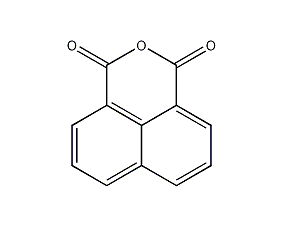
Structural formula
| Business number | 01SG |
|---|---|
| Molecular formula | C12H6O3 |
| Molecular weight | 198 |
| label |
Naphthalene-1,8-dicarboxylic anhydride, Naphtho[1,8,8a-c,d]pyran-1,3-dione, Pesticide intermediates; aromatic carboxylic acids and their derivatives |
Numbering system
CAS number:81-84-5
MDL number:MFCD00006925
EINECS number:201-380-2
RTECS number:QK5350000
BRN number:153190
PubChem number:24886009
Physical property data
1. Character: light yellow crystal
2. Density (g/mL, 25/4℃): Uncertain
3. Relative vapor density (g/mL, Air=1): Uncertain
4. Melting point (ºC): 274℃
5. Boiling point (ºC, normal pressure): Uncertain
6 . Boiling point (ºC, 5.2kPa): Uncertain
7. Refractive index: Uncertain
8. Flash point (ºC): 272℃
9 . Specific rotation (º): Uncertain
10. Autoignition point or ignition temperature (ºC): Uncertain
11. Vapor pressure (kPa, 25ºC): Uncertain
12. Saturated vapor pressure (kPa, 60ºC): Uncertain
13. Heat of combustion (KJ/mol): Uncertain
14. Critical temperature (ºC): Uncertain
15. Critical pressure (KPa): Uncertain
16. Log value of oil-water (octanol/water) partition coefficient: Uncertain
17. Explosion upper limit (%, V/V): Uncertain
18. Explosion lower limit (%, V/V): Uncertain
19. Solubility : No boiling point, insoluble in water, ether, benzene, slightly soluble in hot ethanol, soluble in hot acetic acid.
Toxicological data
1. Acute toxicity
Rat caliber LD50: 12340 mg/kg; rat abdominal LD50: 200 mg/kg;
Mouse caliber LD50: 1600 mg/kg ;Mouse abdominal cavity LD50: 400 mg/kg;
Rabbit skin LD50:>2025mg/kg;
Bird caliber LD50: 4100 mg/kg;
Duck caliber LD50:>6180 mg/kg;
Ecological data
None yet
Molecular structure data
1. Molar refractive index: 53.52
2. Molar volume (cm3/mol): 136.6
3. Isotonic specific volume (90.2K ): 388.0
4. Surface tension (dyne/cm): 64.9
5. Polarizability (10-24cm3):21.21
Compute chemical data
1. Reference value for hydrophobic parameter calculation (XlogP): None
2. Number of hydrogen bond donors: 0
3. Number of hydrogen bond acceptors: 3
4. Number of rotatable chemical bonds: 0
5. Number of tautomers: None
6. Topological molecule polar surface area 43.4
7. Number of heavy atoms: 15
8. Surface charge: 0
9. Complexity: 282
10. Number of isotope atoms: 0
11. Determine the number of atomic stereocenters: 0
12. Uncertain number of atomic stereocenters: 0
13. Determine the number of chemical bond stereocenters: 0
14. Number of uncertain chemical bond stereocenters: 0
15. Number of covalent bond units: 1
Properties and stability
This product is toxic. Its toxicity is similar to that of phthalic anhydride. It can irritate the eye mucosa and respiratory tract. Oral administration of LD5012340 mg/kg to rats. Contact with eyes and mouth should be avoided. Protective glasses and masks should be worn during operation. If accidentally contaminated, it can be treated as a general irritation.
Storage method
Keep sealed in a cool place. Packed in sacks lined with plastic bags to protect against heat, moisture and sun, and stored in a cool, ventilated and dry place. Store and transport according to regulations on toxic and hazardous
dangerous goods.
Synthesis method
Industrial acenaphthene is vaporized with primary air, mixed with secondary air, oxidized to 1,8-naphthalenedicarboxylic anhydride using cobalt as a catalyst, and then cooled.

Purpose
Used as an intermediate for dyes, pesticides, pharmaceuticals and polyester resins.
It is used to prepare fluorescent dyes and is also an important raw material for the synthesis of perylene dyes, pigments and fluorescent whitening agents, such as dispersed fluorescent yellow II and reduced gray BG.

 微信扫一扫打赏
微信扫一扫打赏

